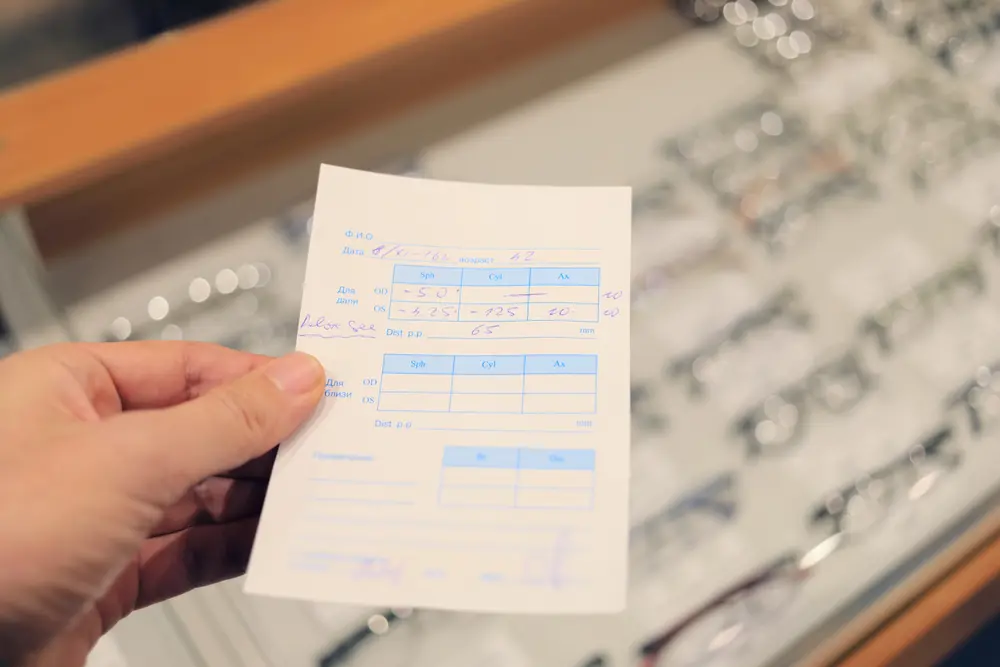
Have you ever looked at your eye prescription and didn’t quite understand it? You’re not alone. An eye prescription is a detailed document that describes the type and extent of vision correction you need. It’s created by your eye care professional after a comprehensive eye examination and contains crucial information about your visual health.
But why is it important to understand your eye prescription? For starters, it helps ensure you get the right corrective lenses, whether they’re glasses or contact lenses. More importantly, knowing how to read your prescription can give you valuable insights into your eye health and vision needs.
Understanding your eye prescription is also particularly useful if you’re considering corrective eye surgery, such as LASIK. It provides important information about your refractive errors — like nearsightedness, farsightedness, or astigmatism — which are key factors in assessing your eligibility for laser eye surgery.
In this blog post, we’ll break down the components of an eye prescription, helping you decipher what each number and abbreviation means. Whether you’re simply curious about your vision or actively exploring options for vision correction, this guide will empower you with the knowledge to better understand your eye health.
Understanding Your Eye Prescription Chart
Your eye prescription chart is filled with numbers and abbreviations that indicate eye shape and vision strength. In the following section, we’ll break down what these abbreviations and numbers mean to help you understand whether you have nearsightedness, farsightedness, or astigmatism.
OD and OS
“OD” and “OS” refer to your right and left eyes, respectively. OD always comes before OS on a prescription because that is how doctors see your eyes when they face you.
- OD (Oculus Dexter): Right eye
- OS (Oculus Sinister): Left eye
- OU (Oculus Uterque): Both eyes
Sphere (SPH)
Measured in diopters, SPH refers to the lens power needed to correct your nearsightedness or farsightedness. When the number in this section is accompanied by a plus sign (+), your farsightedness is corrected. When accompanied by a minus sign (-), your nearsightedness is corrected.
Cylinder (CYL)
CYL refers to the lens power needed to correct astigmatism. Like SPH, if the number is accompanied by a (+), it corrects farsighted astigmatism. If the number is accompanied by a (-), it corrects nearsighted astigmatism. If this section is empty, you do not have astigmatism.
Axis
Ranging from one to 180 degrees, the axis describes the lens meridian, or orientation, of astigmatism correction.
Addition (ADD)
ADD is always a positive number and indicates the additional magnifying power needed to correct presbyopia, a type of farsightedness that occurs naturally with age.
Prism
Measured in prism diopters (p.d.), prism refers to the amount of prismatic power needed to correct eye alignment issues.

Abbreviations in Your Glasses Prescription Explained
Other common abbreviations you’ll encounter when learning how to read a glasses prescription include:
- DS (Diopters Sphere) — the unit of measurement that quantifies the refractive power of your lens
- NV (Near Vision) — how you see objects close up
- DV (Distance Vision) — how you see objects far away
What Your Eye Prescription Says About Your Vision
Nearsightedness (Myopia)
Negative numbers (-) indicate nearsightedness (myopia). For example, -3.00 means you have difficulty seeing distant objects clearly.
Farsightedness (Hyperopia)
Positive numbers (+) signify farsightedness (hyperopia). A +3.00 prescription means you struggle with close-up vision.
Astigmatism
CYL and Axis work together to correct astigmatism, a condition where your eye isn’t perfectly spherical causing blurred or distorted vision at any distance. The CYL number indicates the degree of astigmatism, and the Axis (1-180 degrees) shows the orientation of the astigmatism correction.
Presbyopia
Presbyopia is a condition that refers to age-related farsightedness. The ADD section on your eye prescription chart refers to additional magnification needed to correct this condition. In other words, it’s like having reading glasses incorporated into your regular lenses.
Am I a Candidate for LASIK With My Prescription?
LASIK is a popular refractive surgery that can significantly reduce dependence on glasses or contact lenses for many people. While your eye prescription chart is an important factor in determining your eligibility for LASIK, it’s not the only consideration.
General Prescription Guidelines for LASIK:
- Nearsightedness (Myopia): LASIK is generally most effective for prescriptions up to -8.00 diopters.
- Farsightedness (Hyperopia): Prescriptions up to +6.00 diopters may be eligible.
- Astigmatism: LASIK can often correct astigmatism up to 6.00 diopters.
Remember: these are just guidelines. It’s important to note that even if your prescription falls within these ranges, other factors may influence your eligibility. Conversely, some people outside these ranges might still be candidates for LASIK or alternative refractive surgeries.
Factors beyond your glasses prescription that may impact your candidacy for LASIK include:
- Age: Ideal candidates are typically between 18 and 60 years old.
- Stable Vision: Your prescription should have remained stable for at least one year.
- Overall Health: General health is important for proper healing.
- Eye Health: Your eyes should be free from diseases or conditions that could affect healing.
- Corneal Thickness: Adequate corneal thickness is crucial for safe LASIK surgery.
Even though you know how to read an eye prescription now, the best way to determine if you’re a good candidate for LASIK is to schedule a comprehensive eye exam and consultation with a qualified LASIK surgeon at Toledo LASIK. We will evaluate your overall eye health, corneal thickness, pupil size, and other factors to determine if LASIK is right for you.
Eye Prescription FAQ
What does a negative sign (-) on my prescription mean?
A (-) on your eye prescription chart refers to the lens power needed to fix nearsighted vision. This means you see well up close and require help seeing objects that are far away.
What does a plus sign (+) on my prescription mean?
A (+) on your eye prescription chart refers to the lens power needed to correct farsighted vision. This means you see better far away and need help seeing objects close-up.
Can I use my eye prescription to order contact lenses?
No, your eyeglass prescription cannot be used to order contact lenses. Because they do not include certain data specific to contact lens prescriptions, eyeglass prescriptions are suitable only for lenses situated away from the eyes. Contact lenses, on the other hand, rest directly on the eyes and require a different prescription.
How long is an eye prescription valid?
While gradual vision changes occur naturally over time, your eye prescription generally won’t change unless you suffer an injury or develop presbyopia. However, it’s always recommended to schedule annual eye exams to monitor eye health and track these gradual changes over time if they impact your eye prescription chart.





